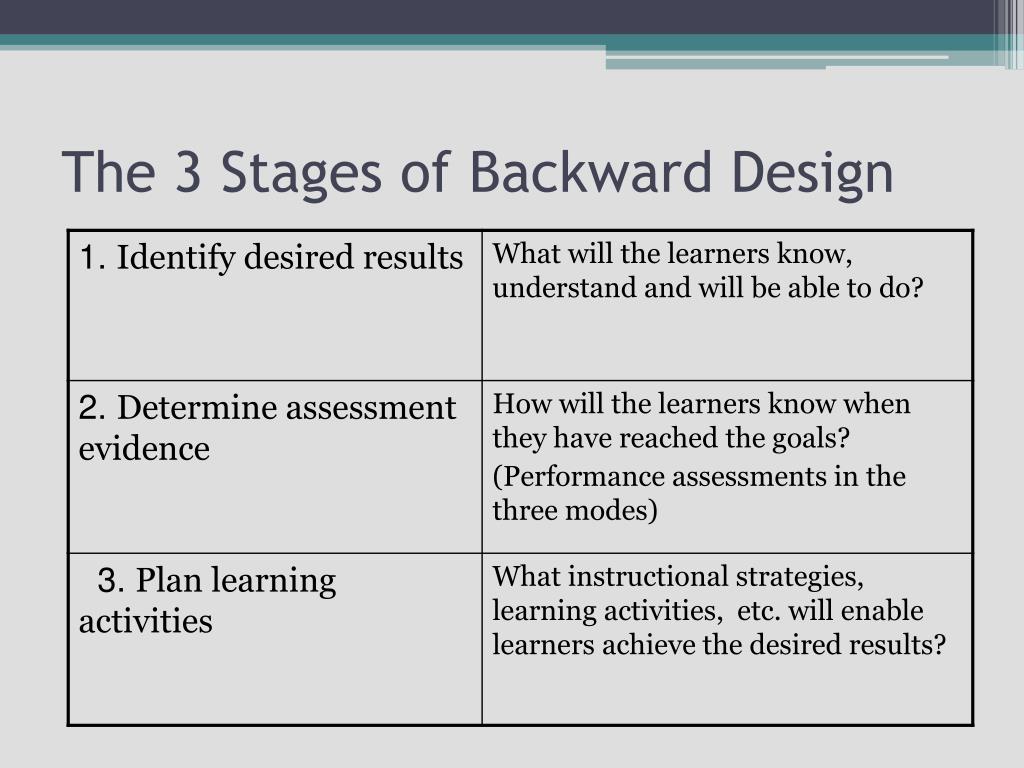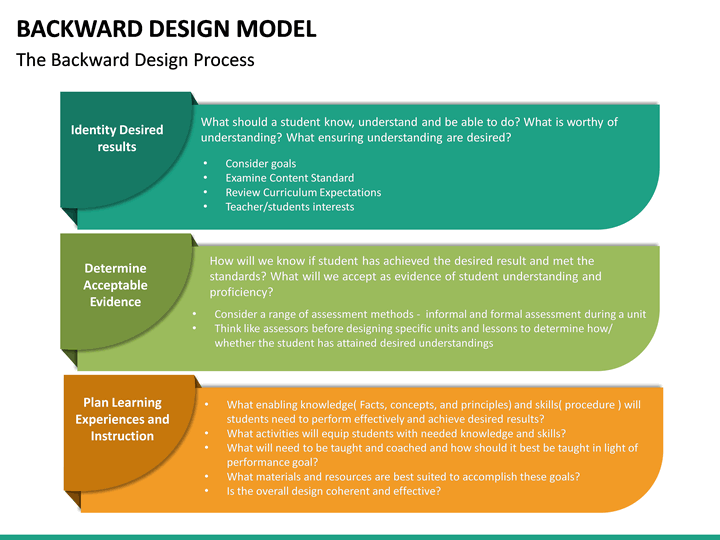Table Of Content

The first step of backward design involves taking a close look at the standard that students should have mastered by the end of a teaching segment. The teacher needs to clearly determine what defines success according to what the student needs to know and to what degree the student needs to be able to use what he/she knows. Before implementing a new curriculum design strategy like Backward Design, it's often beneficial to consult with school or organizational administrators. Doing so can ensure alignment with broader educational goals and compliance with any applicable standards or regulations.
9 Tips for Success as an Instructional Designer - Campus Technology
9 Tips for Success as an Instructional Designer.
Posted: Wed, 15 Feb 2023 08:00:00 GMT [source]
The benefits & advantages of online learning
Depending on your class and what you teach, you may have multiple assessments throughout the course or just one at the very end. If you have just a final assessment, make sure that you model teaching tactics or learning activities toward that test as much as possible. Instructional strategies are the teaching methods by which you present new information to your students. Methods can include teacher-centered approaches like demonstrations or lectures, or student-centered approaches like peer discussion and inquiry-based learning. An integration of “backwards planning” unit design with the “two-step” lesson planning framework – This article takes a look at the process of backwards planning in a detailed case study of a math class.
Integration into Curriculum Planning
If you have a goal that has zero corresponding outcomes, it should not be a learning goal for your course. If you have a goal that has far too many corresponding outcomes, there may be another goal floating among them that you haven't articulated yet. If you have learning goals that are closely related, you may have learning outcomes that correspond to more than one goal in your course. This common approach to course design looks reasonable at first glance, but it also presents some challenges. As experts in their fields, instructors are not always the best judges of what their more novice students might find engaging.
Teaching and Learning Without Grading - Faculty Focus
Teaching and Learning Without Grading.
Posted: Mon, 08 Nov 2021 08:00:00 GMT [source]
Benefits of using a backward design lesson plan
This prevents your tests and assessments from feeling useless at best and contrary or irrelevant to your students at worst. The following examples are simply suggestions for what creating backward design lesson plans might look like. When creating your own lesson plans, please refer to your state’s or school’s specific academic standards. What do you want students to know or be able to do at the end — explain how cells work? (16 PD Hours) This course will teach you the different types of assessments, how to design effective and targeted assessment items, and how to build a detailed plan for your content area and grade-level to measure student progress. In short, by using backward design, an instructor chooses all course materials and activities in order to support an end objective rather than defining the end objective as a summary of the materials covered along the way.
For Programs and Units
In their excellent book, Understanding by Design, Wiggins and McTighe propose the “Backward Design” framework for course design. This framework is “backward” only to the extent that it reverses the typical approach, so that the primary focus of course design becomes the desired learning outcomes. Only when one knows exactly what one wants students to learn should the focus turn toward consideration of the best methods for teaching the content, and meeting those learning goals. Normally, or with traditional lesson planning, you focus on standards and learning objectives. Design your tests and assessments first, then figure out your lesson plans, then teach your students. Some teachers may fear that backward design emphasizes “teaching to the test,” which puts unfair pressure on students to learn for the sake of the final assessment.
This method is rooted in the constructivist theories of educators like Jean Piaget. Like Backward Design, Inquiry-Based Learning encourages higher-order thinking skills. However, it differs in that the learning process is far less structured, often initiated by a question or problem posed by the students themselves rather than pre-defined learning objectives. You might hear teachers asking, "What are the desired outcomes?" or "What evidence of learning will we accept?" These questions show that the influence of Backward Design is widespread and still growing. Backward design provides a relevant context for students as they engage in learning activities.
Alignment of learning objectives to learning activities
The knowledge and skills at this substage are considered important to know and do. The information that fits within this question could be the facts, concepts, principles, processes, strategies, and methods students should know when they leave the course. The teacher has created an authentic task in which students will design a 3-day meal plan for a camp that uses food pyramid guidelines. By way of example, consider a paralegal instructor who wants students, as a result of her instruction, to be able to prepare case briefs.
Is It Suitable for All Learners?

The whole time, they are using the lunar cycle vocabulary, correcting each other’s misconceptions, and just like scientists, thinking about how to explain concepts to other people. The test asks students a lot of questions that would show an understanding of these concepts, so we’re covered. Some chapters we did in class (I would read to them, then they would read silently), and others at home. Some students became as absorbed in the novel as I’d hoped they would; others, not so much.
The Before, Where the Final Product is a Test
With a good rubric in place, we then work backwards to determine what lessons students need to do excellent work on the final assessment. So if we re-do this unit plan with backward design, we’ll need to start by developing an assessment that would measure success with that standard. If we assume that a large portion of a student’s grade is based on the test, then students are not being measured on their achievement of that standard. Nor does it ask them to “demonstrate knowledge” of how the whole system works. The standard wants students to develop a model and use it to describe the system.
Backward Design serves as more than just a tool for curriculum planning; it represents a shift in how we think about education. Instead of starting with what educators want to do, it starts with what students need to learn. This learner-centered focus makes it a powerful approach for modern education, where student engagement and outcomes are increasingly emphasized. Educational technology experts like Dr. Ruben Puentedura, known for the SAMR model, suggest that technology can play a powerful role in implementing Backward Design. Whether it's digital assessments or interactive activities, technology can offer innovative ways to achieve your learning objectives.
Traditional or “frontloading” and backwards or “backloading” design models are used to create curriculum, and both have benefits. In schools or districts where aims, goals and objectives are the focus, the traditional model is probably the best choice. In many districts, backwards design is used because there is an expectation that students should attain high test scores.
The middle circle identifies what is important to know such as important knowledge (i.e, facts, concepts, and principles), as well as skills, processes, strategies, and methods. No matter your teaching modality, Ohio State has a professional learning program designed to support you with course design. Successful completion of each option below also earns you a teaching endorsement for Course Design in Higher Education. With this “after” version, every lesson is designed to prepare students to give excellent presentations at the end.
Once you're comfortable with the approach, you can expand to more complex planning projects. While these challenges and criticisms provide a more nuanced view of Backward Design, they don’t necessarily invalidate its effectiveness. Many educators find ways to adapt the approach to suit different learning environments and needs. Because understanding how Backward Design works can make anyone a better learner and even a better teacher, whether you're helping your kid with homework or leading a team at work.
In this model, traditional classroom activities and homework assignments are reversed. Teachers like Aaron Sams and Jonathan Bergmann have popularized this approach, which often involves students watching lectures at home and engaging in activities during class. While the Flipped Classroom also aims for active learning and engagement, it doesn’t necessarily start with specific outcomes in mind, making it different from Backward Design in its initial focus. Popularized by education reformers like John Dewey, Project-Based Learning focuses on complex questions or challenges that require students to engage in critical thinking, problem-solving, and collaboration.
Plus, it's a learning tool that schools and companies are using more and more, so it's good to know what it's all about. The inner circle identifies enduring understandings or big ideas that students should retain after they have forgotten many of the details (Wiggins and McTighe 1998, 9-10). Ohio State historyLong before Wiggins and McTighe popularized backward design, Ralph Tyler was working with fellow faculty at The Ohio State University to improve data gathered from assessments.

No comments:
Post a Comment